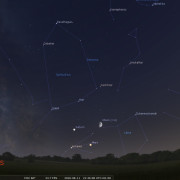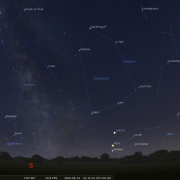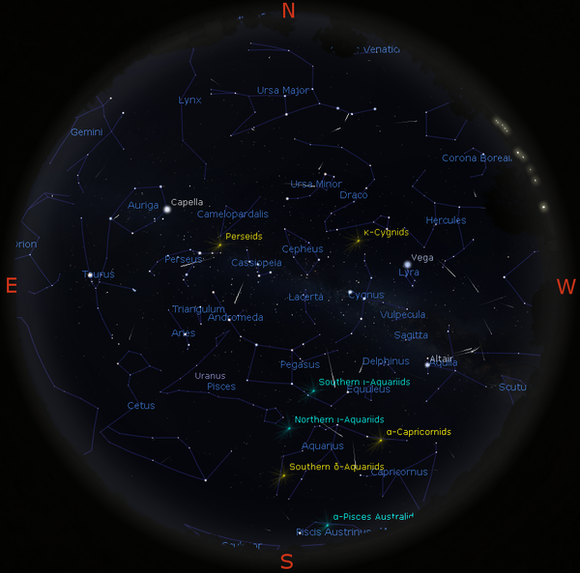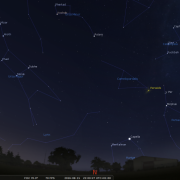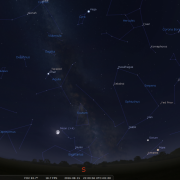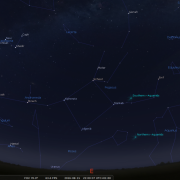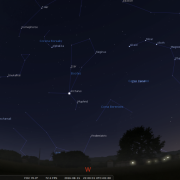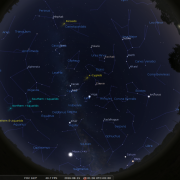In this month's Sky Notes:
Planetary Skylights
Three major planets are now visible in the late evening sky, Jupiter, Mars and Saturn.

 Jupiter is finally swamped by bright twilight low in the west and will only be readily visible until mid month; thereafter it will be more difficult to spot. The crescent Moon lies nearby on the 5th.
Jupiter is finally swamped by bright twilight low in the west and will only be readily visible until mid month; thereafter it will be more difficult to spot. The crescent Moon lies nearby on the 5th.

 As the king of the planets departs in the west, look out for Venus and Mercury also in the western twilight sky. Venus will be located around a hand span lower right of Jupiter, just a few degrees above the horizon, with elusive Mercury in between, but nearer Venus. View from the 5th onwards approximately 20 minutes after sunset, use binoculars if necessary. A young crescent moon will also be visible. Jupiter and Venus appear extremely close on the 27th , but are just 2 degrees above the horizon in a bright sky.
As the king of the planets departs in the west, look out for Venus and Mercury also in the western twilight sky. Venus will be located around a hand span lower right of Jupiter, just a few degrees above the horizon, with elusive Mercury in between, but nearer Venus. View from the 5th onwards approximately 20 minutes after sunset, use binoculars if necessary. A young crescent moon will also be visible. Jupiter and Venus appear extremely close on the 27th , but are just 2 degrees above the horizon in a bright sky.

 The red planet Mars remains a fairly conspicuous presence low in the SW, its orange tinge readily identifiable. Mars is moving eastwards towards the bright orange star Antares (chief star in Scorpius) with Mars located above Antares towards the end of the month. Mars is also moving toward the other planet visible in this general direction; Saturn. Through a telescope Mars appears small, orange and pretty featureless; Saturn on the other hand has the glorious ring system on offer, a real observing tonic. The moon lies near Mars and Saturn on the 11th&12th.
The red planet Mars remains a fairly conspicuous presence low in the SW, its orange tinge readily identifiable. Mars is moving eastwards towards the bright orange star Antares (chief star in Scorpius) with Mars located above Antares towards the end of the month. Mars is also moving toward the other planet visible in this general direction; Saturn. Through a telescope Mars appears small, orange and pretty featureless; Saturn on the other hand has the glorious ring system on offer, a real observing tonic. The moon lies near Mars and Saturn on the 11th&12th.
| Looking South on 11-Aug-2016 at 21:45h: Moon, Saturn and Mars. (Click image for full-size view) |
Looking SW on 24-Aug-2016 at 21:15h: Saturn and Mars. |
Meteor Showers

When amateur astronomers refer to the ‘glorious 12th’ they are not contemplating shooting grouse, pheasant or any other bird, they are however anticipating shooting stars. The ‘shooting stars’ in question are the Perseids, one of the more reliable meteor showers and undoubtedly the most widely observed by the general public given that the shower occurs during the warmer summer months and requires only naked eye. Perseids are so called because their radiant; the location in the sky from which the meteors appear to emanate, lies within the constellation of Perseus.
In some regions of the world the Perseids are also known as "The Tears of St. Lawrence", because the feast day of that saint falls on Aug 10th, just two days before the meteor peak. Laurentius, a Christian deacon, was said to have been martyred by being roasted alive on an iron outdoor stove by the Romans in 258 AD. It was in the midst of this torture that Laurentius cried out: "I am already roasted on one side and if thou wouldst have me well cooked it is time to turn me on the other."
These particular ‘tears’, like the majority of meteor showers, are a classic example of a cometary meteor stream, debris deposited over many thousands of years by periodic comets. Perseids are associated with comet Swift Tuttle which was discovered in 1862 taking approximately 130 years to orbit the Sun. With each pass the comet leaves behind fresh material, these meteoroids are predominantly the size and density of instant coffee granules with the occasional pea or marble sized fragment. Each August, Earth encounters various strands of the Swift-Tuttle debris stream giving rise to the eagerly anticipated shooting stars. Perseid meteoroids penetrate the upper atmosphere some 60 miles up at speeds of 37-43 miles/sec. As they do so the atoms of the particle interact with the atoms in the atmosphere and through a process known as ablation become ionised, releasing a packet of light. It is this brief luminous flash we call a meteor. Particularly bright examples often leave behind persistent ionisation trails in their wake, the classic shooting star.
Perseid activity is highest from Aug 8th-15th with the Perseid maximum in 2016 predicted for August 12th at 13:00h UT. The best observed rates are therefore likely to be seen late in the night of August 11-12th, but good rates are also likely during the nights of August 10-11th and 12-13th, so don't just focus on the night of Aug 11-12 (and risk it being clouded out).
There is a good chance of higher than usual Perseid activity this year, due to a 12 year periodicity in Perseid rates caused by perturbation of the meteor stream by Jupiter. This has previously enhanced Perseid rates in 1968, 1980, 1992 and 2004. Even better news for observers in the UK is that predictions indicate that the enhancements will occur during UK hours of darkness.
Under ideal conditions the zenith hourly rate (ZHR) for the Perseids is typically 60-80 per hour. This assumes the radiant is overhead, light pollution is minimal and the observer has all round vision. Obviously then, such rates are rarely witnessed. This year moonlight from a gibbous moon will interfere before midnight, however post midnight hours (normally best anyway) should be ideal. Expect 10-15 per hour before 12 am and 40-50 in the early morning hours.
Observing meteors can be frustrating, just like the preverbal bus you can seemingly wait ages for one and then several appear within a few seconds. Have patience, wear warm clothing and perhaps have a warm drink and a snack to hand. Some people watch from a deck chair or lie-low. Although you will catch some meteors before midnight, the majority streak across the early morning sky, when our part of the world becomes the ‘leading’ hemisphere, and faces directly into the path of oncoming particles.
Regions of the sky that often seem productive include; the ‘Summer Triangle’ visible high to the south, the Plough; high in the NW, and the Square of Pegasus, rising to the east. Do no watch in the part of the sky Perseus occupies; ie over in the northeast. Shower members appearing close to the radiant have foreshortened tracks; those appearing farther away are often brighter, have longer tracks and move faster across the sky
August 2016 Sky Charts
Click each image to see a full-size Sky Chart:
|
Looking North
Mid-August - 22:00h |
Looking South |
|
Looking East
Mid-August - 22:00h |
Looking West
Mid-August - 22:00h |
|
|
|
|
Overview
9th-August - 22:00h |
|
Additional Image Credits:
- Planets and Comets where not otherwise mentioned: NASA
- Sky Charts: Stellarium Software
- Log in to post comments

